As the RIPE NCC turns 25 years old, we look back at the historic membership growth and distribution of Internet number resources.
Membership growth
After reaching the milestone of 15,000 Local Internet Registries (LIRs) in December 2016, the RIPE NCC membership continued to grow at a fast pace. Between 1 January 2017 and 1 April 2017, a record number of 726 new LIRs were activated – 28 more than in the last quarter of 2016 and four more than the previous all-time record of 722 set in the last quarter of 2015. Figure 1 shows the historic perspective.
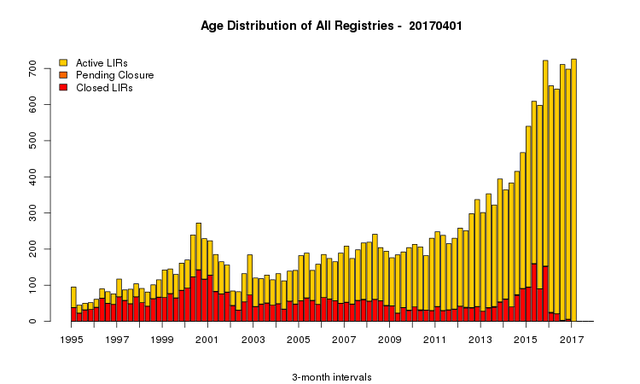
Figure 1: Age distribution of all LIRs. The height of each bar represents the total number of LIRs joined that quarter.
To estimate when the number of LIRs will reach another milestone, we try to model the growth rate. As net growth is the result of new LIRs joining and existing LIRs closing, we model these factors separately. Figure 2 shows how the total number of LIRs, regardless of present state, closed or active, evolved over time. The change in trend after RIPE NCC reached the last /8 of IPv4 in September 2012 is quite clear. In the preceding seven years, growth had mostly been linear; new LIRs were established at a more or less constant rate. After this date, growth accelerated and turns out to be described rather well by a quadratic model.
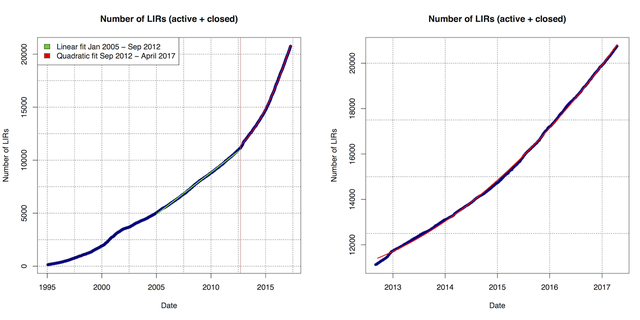
As Figure 1 suggests the rate of acceleration slowed down in the last two years and the zoomed-in graph of Figure 2b shows the model predictions to be slightly higher than the observed values for the past four months, we use the quadratic fit for the period 1 January 2015 - 15 April 2017 to extrapolate growth. This model matches the observed numbers in recent years even better. Assuming the underlying trend does not change, extrapolation foresees a total of 2,940 LIRs joining the RIPE NCC in the year 2017.
For closed LIRs, the evolution of the total number over time is not continuous. Growth here is marked by regular, yearly jumps when a notable number of LIRs are closed at the same time for reasons of non-payment. This makes it more difficult to model the trend. Neither a linear nor quadratic model covers the daily growth well. As illustrated in Figure 3, the observed total number of LIRs that had been closed by April 2017 was much lower than predicted by either model. However, with the month of May, when membership fees are due, the actual number of closed LIRs is likely to reach or exceed the extrapolations from the models again.
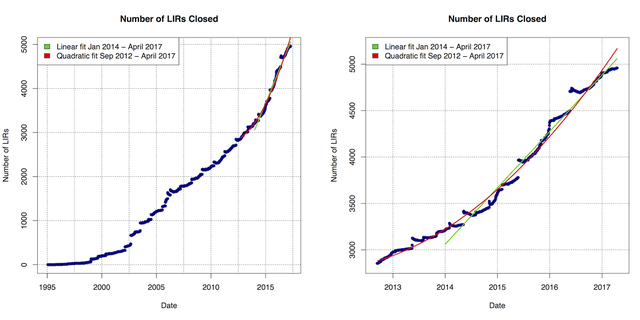
Figures 3 a and 3b: Total number of LIRs that have been closed over time
The linear fit from January 2014 to April 2017 seems to be the better match for the past two and a half years. Still, due to the non-continuous nature of the growth, the fitted line often deviates from actual observations; in 50% of the cases, the difference lies between 50 and 170 LIRs. Keeping these uncertainties in mind, the combined model of new LIRs opening and existing LIRs closing predicts a total number of active LIRs of 17,360 by 31 December 2017, which corresponds to a net growth of 2,350 LIRs over the entire year.
Little more than a year later, on 11 January 2019, the model sees the RIPE NCC reach the milestone of 20,000 active LIRs. However, the uncertainties, especially in forecasting the number of closed LIRs, leads to a spread of about two weeks around this date. In other words, if the trend in membership growth from the past two years continues, the next milestone would be reached sometime between the end of December 2018 and the end of January 2019.
Per country growth
Although the overall growth has been rather smooth in the past 12 years, first linear, then quadratic, the trends on a per country level differ widely. In Figure 4 we show the historic growth of the number of LIRs for the 15 countries that on 15 April 2017 held the most LIRs. We can see how, unlike France, Germany and the United Kingdom, LIRs in Russia were not affected by the burst of the dotcom bubble; from 2000 to 2010 their number increased steadily, making Russia the largest contributor to the RIPE NCC. In 2010, in the wake of the financial crisis, growth in Russia came to a halt, only to pick up again in September 2012 when the RIPE NCC reached the last /8 of available IPv4. However, as growth rates in both Germany and the United Kingdom had increased too, Russia dropped to third place in 2015. In a similar way, both France and the Netherlands have now passed Italy, for a long time the number four country in terms of contributing LIRs.
Finally, it is interesting to see how, unlike other top contributing countries, Sweden recorded a rather modest growth in the past ten years. The rate of growth did not change as drastically there after September 2012. As a consequence, the country dropped from sixth to tenth place in active LIRs on 15 April 2017, just behind the Czech Republic.
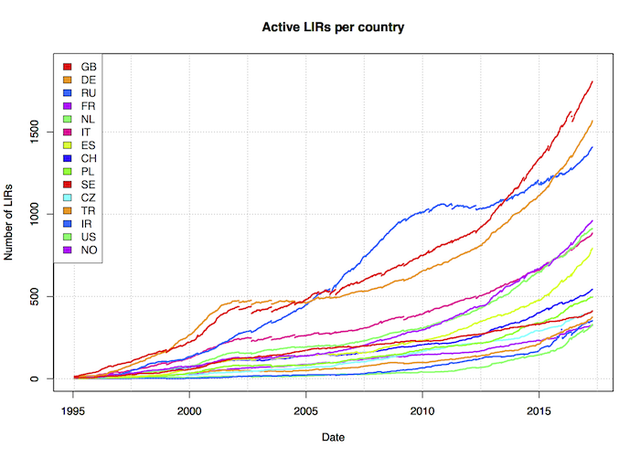
IPv4 address distribution over time
Starting operations on 1 April 1992, the RIPE NCC made 1,000 /24 and 50 /16 assignments in the first three months of its existence. In the next 20 years, IPv4 address distribution continued on a needs-based basis until, on 14 September 2012, the available pool dropped to the level of one /8. Since then every LIR, old and new, is entitled to one final /22 allocation from the remaining pool. Figure 5a shows the evolution of the total IPv4 space managed by the RIPE NCC over the years. Starting in 1996 for practical reasons, we plot the total number of distributed IPv4 addresses present in the RIPE Registry on a daily basis. This is different from plotting the cumulative number of addresses using the actual dates of allocation/assignment because address blocks have been returned and reallocated and because address space can come to or leave the RIPE Registry via inter-RIR transfers. A special case of the latter are the transfers in 2003 and late 2014 of legacy blocks which, historically, have been assigned to organisations in the RIPE NCC service region but were recorded in the ARIN registry. These transfers are very visible in Figure 5a as steep jumps in total address count.
Apart from the discontinuity in 2003, growth had been very steady until September 2012 when the RIPE NCC reached the last /8 of unallocated IPv4 space. At that moment, growth in distributed IPv4 slowed down to a rate where it is hardly visible on the graph, the only significant change being the result of moving 53/8 and 57/8 from ARIN to the RIPE NCC. IPv4 addresses were being allocated according to the last /8 policy but at the same time addresses were coming back to the registry as a result of implementing the "Contractual Requirements for Provider Independent Resource Holders in the RIPE NCC Service Region" policy. As a result, the total distributed address space only increased by 0.2% in two years time. As the project completed in the fall of 2015, growth again became visible but due to the nature of the last /8 policy is much lower than before September 2012.
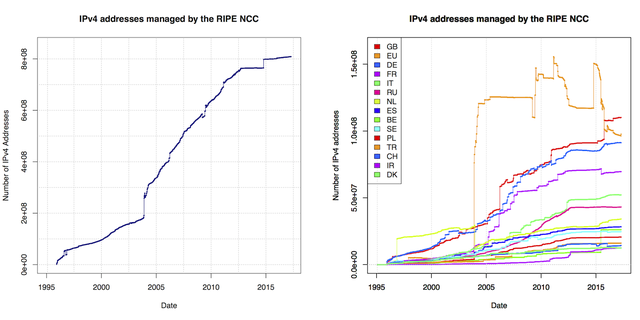
In Figure 5b we look at the growth in IPv4 addresses held (or in case of assignments, sponsored) by LIRs on a per country level. We can see how the United Kingdom, Germany, France, Italy and Russia are in the top five. The dominant feature is, however, the orange line for 'EU'. This tracks the address space that is distributed in the RIPE NCC service region, documented in the RIPE database, but not associated to any LIR account. Most of it is legacy space, as witnessed by the sharp rise in 2003, when a large number of such blocks were transferred from ARIN, but it also included address space that (temporarily) became orphaned in the process of implementing the contractual requirements policy. Following acceptance by the RIPE community of the policy “RIPE NCC Services to Legacy Internet Resource Holders” part of the legacy resources did move to a (sponsoring) LIR. However, on 15 April 2017 about 93 million IPv4 addresses were still without an LIR.
AS Numbers
In Figure 6 we look at the growth in distributed AS Numbers (ASNs) per 1 April 2017. The overall (net) growth shows a remarkably steady rate since the year 2005. With the exception of 2013 and 2014, the past 12 years saw an increase in total distributed ASNs of roughly 2,000 a year. The temporary slowdown in 2013/2014 was not a sign of decreased demand but, as with IPv4 assignments, the result of an increase in deregistrations as a result of implementing the " Contractual Requirements for Provider Independent Resource Holders in the RIPE NCC Service Region " policy.
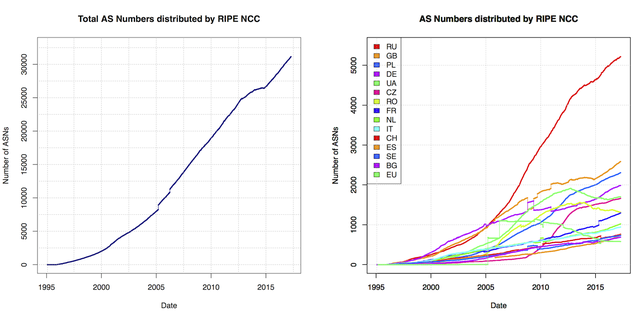
On a per country level, we find Russia in a league of its own. LIRs in this country hold or sponsor twice as many AS Numbers as LIRs in the number two country, the United Kingdom. Compared to the distribution of active LIRs, Poland, Ukraine, Romania and the Czech Republic LIRs also account for a larger fraction of the assigned AS Numbers than one would expect based on their relative contribution to the membership.
As with IPv4, the country code 'EU' represents AS Numbers that do or did not have a sponsoring LIR. Most of these are legacy assignments that entered the RIPE Registry in 2005 and 2006. Since 2010, the number is going down as AS Numbers are returned or moved to an LIR's account. Interestingly, both Ukraine and Romania also show a decline in the total AS Numbers held or sponsored by LIRs in the years 2014-2016. However, where growth in Ukraine rebounded in the last year, the AS Number count for Romania is still decreasing.
IPv6
Figure 7 shows the evolution of IPv6 allocations and assignments by the RIPE NCC to the LIRs. Growth picked up around the time IANA ran out of IPv4 and has been very steady since the RIPE NCC reached its last /8. The policy that required LIRs to hold an IPv6 allocation in order to be eligible for a final /22 IPv4 allocation has been a major contributing factor there. Nevertheless, in the two years that passed since the RIPE community reached consensus to drop the requirement, the number of LIRs holding an IPv6 allocation continues to grow, albeit at a slower rate than the total number of LIRs. For more information, please refer to the recent RIPE Labs article IPv6 RIPEness Through the Years.
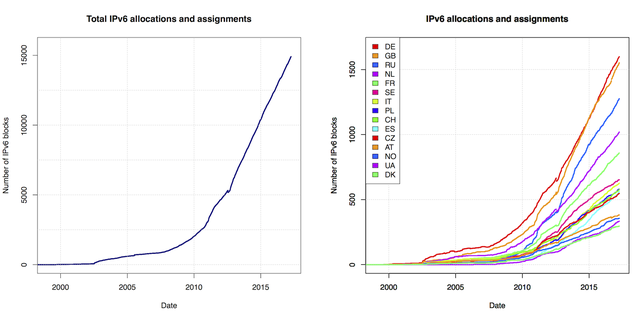
Figure 7: IPv6 allocations and assignments made by RIPE NCC to LIRs
Following the implementation of policy proposal 2011-04, most of the new allocations are /29s. Only occasionally do well-documented requests result in a larger allocation. The largest allocation ever made is a /19, which has happened three times in history, the most recent in July 2016. In total, the RIPE NCC distributed the equivalent of 97,131 /32s by 1 April 2017. This corresponds to 9.3% of the space allocated to the RIPE NCC by IANA. Compared to the entire IPv6 unicast space, 2000::/3, RIPE NCC has handed out 0.2% of what is available.
On the country level, nothing unusual is seen. The top 15 countries holding IPv6 resources are all growing. Holding the most LIRs, it is no surprise Germany, the United Kingdom and Russia form the top three IPv6 holders too. Notable is Sweden, which comes in tenth place when considering number of active LIRs, but climbs back to sixth place when considering number of IPv6 allocations and assignments.
Conclusion
In the past four and a half years the RIPE NCC membership increased at a faster than linear rate. If this trend continues, we can expect the milestone of 20,000 active LIRs to be reached in January 2019. As the RIPE NCC reached exhaustion in September 2012, the IPv4 space allocated to all these new LIRs is only a fraction of what has been distributed before. For long-term growth, LIRs should turn to IPv6.

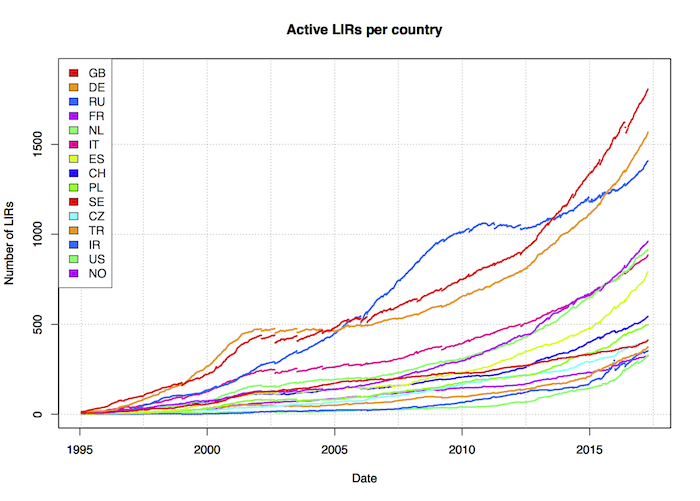

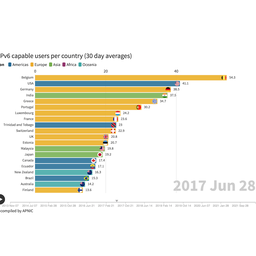
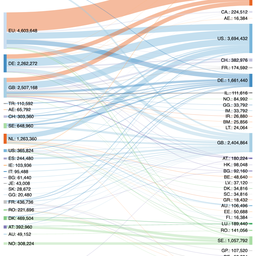
Comments 0
The comments section is closed for articles published more than a year ago. If you'd like to inform us of any issues, please contact us.